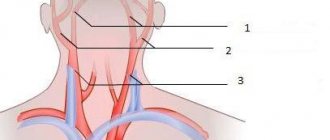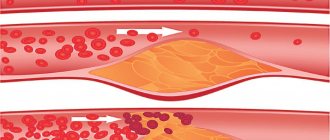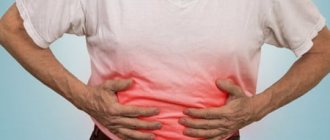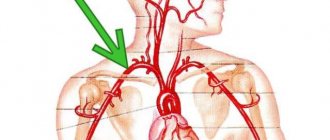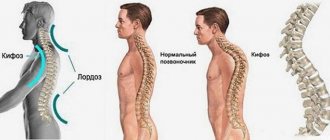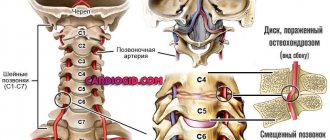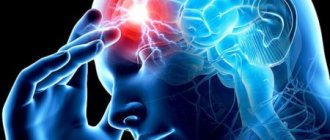The blood vessels of the cervical spine are elastic, smooth muscle, hollow formations that supply blood to the brain. In total, about 15% of the total volume of circulating blood and almost a quarter of the amount of oxygen that a person receives during breathing enters the brain. Vasoconstriction in this section is a form of vascular obstruction and, in the absence of timely correction, can lead to complete occlusion (blockage) of the arteries supplying blood to brain cells. The pathology is dangerous not only due to persistent vertebrobasilar and vegetative-vascular disorders, but also severe organic brain damage: stroke, impaired swallowing and speech function, paralysis of the facial muscles.
Narrowing of blood vessels in the cervical spine
Pathogenetic and morphological changes
The most important blood vessels in the neck are the carotid arteries, through which up to 80% of the blood enters the brain. The remaining volume circulates through the vertebral arteries, which (like the carotid arteries) begin in the chest cavity and supply blood to the posterior parts of the brain and the cerebellum. The vertebral arteries in the central part of the ventral surface of the brain merge to form the main artery, which is called the basilar artery. The outflow of blood to the heart occurs through paired jugular veins, which belong to the superior vena cava system and are located in the cervical spine.
Arteries of the head
The pathophysiological changes during the formation of partial vascular obstruction may be based on two processes.
- Blockage of arteries with blood clots or atherosclerotic plaques. This is the main cause of vasoconstriction in the cervical region, developing against the background of hematological pathologies and atherosclerosis.
Blockage by atherosclerotic plaques - Spasm of blood vessels in the neck and brain . Spasm of blood vessels in most cases is a secondary pathology (a consequence of sclerotic changes in the carotid and vertebral arteries), since prolonged and strong contraction of the muscle walls occurs against the background of acute or chronic tissue hypoxia.
Cerebral vasospasm
When blood vessels narrow, their capacity decreases, which leads to insufficient supply of blood enriched with oxygen and nutrients to the cells of the brain and cerebellum. At the initial stage, the disease may not manifest itself in any way, but with a chronic course, the patient develops characteristic clinical manifestations and complaints: headache, tinnitus, dizziness, instability of blood pressure and other symptoms of vertebrobasilar insufficiency.
Note! Symptoms of stenosis are usually more pronounced if the carotid arteries are affected, since they supply the brain with the bulk of the blood necessary for normal functioning (about 70-80%).
Symptoms of carotid artery stenosis
Treatment
A pinched nerve in the cervical spine needs to be treated comprehensively. Based on the diagnostic results, an individual therapeutic program is formed for each patient, which includes methods of multidirectional effects on the spine. For osteochondrosis and other vertebrogenic pathologies, the following techniques have a positive effect:
- Drug therapy.
- Physiotherapy.
- Massage.
- Manual therapy.
- Physiotherapy.
- Operation.
To relieve the strain on the neck, patients are advised to wear a Shantz collar and sleep on a hard mattress with a bolster under their head. If pain occurs, you should not make sudden movements, but should consult a doctor as soon as possible.
The choice of one method or another is determined by the clinical situation and standards of care for diseases of the spinal column.
Drug therapy
Neck pinching due to osteochondrosis begins to be treated with medications. They have a fairly quick effect, relieving acute symptoms and improving the condition of patients. In most cases, the following drugs are prescribed:
- Non-steroidal anti-inflammatory drugs (Ortofen, Movalis, Nimesil).
- Muscle relaxants (Mydocalm).
- B vitamins (Vitaxon, Milgamma).
- Chondroprotectors (Arthra, teraflex).
Vertebral artery syndrome, as a rule, does not require separate drug correction, but sometimes it may be necessary to prescribe antispasmodics (No-shpa, Dibazol). A separate role is given to medications for topical use - after eliminating acute symptoms, an ointment or gel is prescribed (Voltaren, Finalgon). But if severe pain is not eliminated, paravertebral blockades with local anesthetics (Novocaine) are performed.
Physiotherapy
Treatment of acute neck pain can be supplemented with physical methods. Thanks to deep heating of tissues, biochemical processes in them are improved, inflammation and swelling are relieved. For spinal pathologies, the following procedures are often prescribed:
- Electrophoresis.
- UHF therapy.
- Laser treatment.
- Magnetotherapy.
- Hirudotherapy.
- Balneotherapy.
When using physiotherapeutic agents, they take into account not only the main diagnosis, but also concomitant diseases that the patient probably has.
Massage
Osteochondrosis of the cervical spine is an indication for therapeutic massage. This method is widely popular because it is beneficial for the spine and pleasant for the patient. Eliminating muscle spasms and improving local blood flow helps treat many diseases of the axial skeleton. Manual massage techniques for the neck and collar area are used, which include the following elements:
- Stroking.
- Trituration.
- Kneading.
- Pressure.
Movements are carried out in the direction from the head to stimulate venous and lymphatic drainage.
It should be remembered that massage is performed after eliminating acute signs of pinching, as it can provoke pain.
Manual therapy
Along with massage, manual therapy methods include manual therapy. Using special techniques, the doctor performs passive traction, torsion, flexion and extension of the spine. At this time, a characteristic crunch is felt, which is quite normal. This eliminates subluxations of small joints and muscle blocks, and improves the biomechanics of the cervical spine.
Pathology of the cervical spine should be treated carefully, trusting only qualified manual therapy specialists.
Physiotherapy
Complete treatment of vertebrogenic pathology cannot do without gymnastics. Individual exercises are developed for each person, which makes them as effective as possible. To eliminate compression of the roots, traction therapy is performed, due to which the intervertebral spaces widen.
To improve the mobility of the cervical spine, flexion and extension exercises are performed, and muscle strengthening is achieved after training using the post-isometric relaxation technique.
If you follow all the doctor’s recommendations, then gymnastics is a good way to treat your neck at home.
Possible reasons
There are quite a few reasons that can provoke stenosis of the carotid or vertebral arteries. The main risk factor is atherosclerosis - a chronic pathology characterized by the deposition on the walls of blood vessels of cholesterol, as well as some complex proteins consisting of fatty acids, phospholipids and neutral fats. The basis of pathophysiological changes in atherosclerosis of the carotid arteries and basilar artery is a violation of lipid and protein metabolism, which can be facilitated by excess body weight, endocrinological pathologies, smoking, chronic intoxication of the body with toxic substances (wine alcohol, heavy metals, harmful emissions, etc.) .
Carotid artery stenosis
Among other possible causes of vasoconstriction in the cervical spine, experts also name the following diseases and pathological conditions:
- arterial hypertension in the subcompensation stage (maintaining pressure at 140/90 mm Hg);
- an eating disorder, expressed in frequent and abundant consumption of foods high in fat (in 60% of patients with this diagnosis, the level of total cholesterol exceeds 5 mmol/l);
- diabetes;
- hypodynamic disorders of blood circulation and respiratory function associated with a sedentary lifestyle and prolonged stay in a static position (sedentary work).
Symptoms of diabetes
Spasm of the neck vessels, which also narrows the lumen and impairs the patency of the artery, can occur against the background of chronic heart diseases (coronary artery disease, tachycardia, angina pectoris, arrhythmia, etc.), as well as nervous and emotional overload. Muscle tension is the body’s physiological response to stress, so psycho-emotional factors with prolonged exposure can cause chronic vasoconstriction of the neck and head.
Connection with osteochondrosis
Narrowing of blood vessels in the cervical region can also be the result of degenerative changes in this segment of the spine. The cervical vertebrae are connected to each other using elastic formations consisting of fibrocartilaginous ring plates. Such formations are called intervertebral discs. Inside they are filled with a gelatinous jelly-like substance - the nucleus pulposus, which acts as a shock absorber. The pulp is nourished by blood vessels located in the central spinal canal.
What are intervertebral discs
Dystrophy of the disc nucleus is manifested by its dehydration and drying out, as a result of which the fibrous membranes surrounding the disc become thinner and cannot tightly hold the jelly-like nucleus in an anatomically correct location. The pulp is displaced and disc bulges (protrusions) or protrusions (hernias) form. Intervertebral hernias in the cervical region are more dangerous, since they are large in size, and if left untreated for a long time, there is a high risk of sequestration - complete separation of the nucleus pulposus from the intervertebral disc and its prolapse into the spinal canal.
One of the manifestations of osteochondrosis and its complications is compression (squeezing) of nerve endings. A hernial protrusion can also put pressure on the blood vessels located in the neck, causing them to narrow and spasm. Osteophytes - bone growths in the form of hooks and spines, mainly along the edges of the vertebral body and spinous processes - can also cause pinching of neck vessels.
Vertebral artery
What to do if the vessels in the neck are pinched: symptoms
In conditions of total physical inactivity, modern people often experience discomfort in the spine and neck. It often turns out that it compresses the vessels in the neck, the symptoms of which are very unpleasant for the patient.
The cervical spine is the most vulnerable due to its anatomical features. The cervical vertebrae are located very close to the arteries and nerve endings, and the slightest displacement is fraught with clamping of the cervical vessels and the formation of an intervertebral hernia. That is why, if the slightest discomfort occurs, you must consult a doctor and undergo an examination.
The most common cause of compression of the cervical vessels is osteochondrosis, which causes degenerative changes in the vertebrae and disrupts normal blood circulation to the brain.
Causes
There are many reasons for the appearance of osteochondrosis of the cervical spine:
- passive lifestyle. Most people spend most of their time sitting. Working at a computer, driving a car, watching television for a long time - all this contributes to the development of the disease;
- salt deposition in the cervical spine. To avoid the development of such a situation, it is necessary to regularly undergo massage courses;
- eating disorder. Due to improper nutrition, metabolism can be disrupted, which is why osteochondrosis of the cervical spine develops.
The following factors contribute to the development of cervical osteochondrosis:
- hereditary predisposition;
- hormonal imbalances;
- injuries, including bruises;
- hypothermia of the neck;
- excess body weight;
- excessive stress on the neck when playing sports;
- wrong pillow size;
- nervous tension;
- poor posture;
- infectious diseases of the musculoskeletal system.
Signs
The symptoms of compression of blood vessels in the neck are very similar to the signs of a number of other diseases, which makes the rules for making a diagnosis more difficult.
Symptoms that the vertebrae are compressing the vessels in the neck are:
- frequent headaches. Due to poor circulation and compression of nerve endings, the patient is usually bothered by headaches, which intensify with sudden turns of the head. As a rule, discomfort is localized in the area of the back of the head and temples, gradually spreading throughout the head;
- dizziness, especially with sudden tilts or turns of the head;
- tinnitus, often disturbing in the morning;
- nausea and vomiting for no apparent reason;
- pain in the area of the heart, while there are no abnormalities on the cardiogram. At the same time, discomfort increases when moving the head and arms, and weakness and numbness of the fingers are also felt;
- occasional mild pain in the neck and shoulders. Over time (after morning exercises) the discomfort completely disappears;
- cervical lumbago, when it is impossible to turn the head;
- crunching when turning your head;
- deterioration of vision and hearing.
To diagnose the location of compression of the cervical blood vessels, it is necessary to try to clearly determine the localization of the disorder.
For example, if the nerve root of the first cervical vertebra is compressed, the patient is bothered by pain in the occipital part of the head. Compression of the nerve and blood vessels in the area of the third vertebra is fraught with speech impairment and numbness of the neck.
If there are disturbances in the area of the fourth vertebra, breathing is impaired and muscle tone decreases.
What is the danger of squeezing blood vessels?
Compression of neck vessels is a life-threatening condition. The small cervical region contains a very large number of blood vessels and nerve endings that supply the organs of the head, including the brain. In case of the slightest compression, metabolism is disrupted and cerebral circulation is impaired.
Due to compression of blood vessels, brain hypoxia, vegetative-vascular dystonia, and problems with hearing and vision develop. More serious consequences are ischemia of the spinal cord and brain, the development of spinal stroke. In case of strong compression, death is possible. To avoid serious consequences, it is necessary to start treatment in a timely manner.
Treatment
Treatment of vascular compression is a complex task, for which it is necessary to take comprehensive measures. The most effective way to combat osteochondrosis is therapeutic massage, physical education and physiotherapy.
Massage performs the following functions:
- reduction of pain in the affected area;
- improvement of blood circulation;
- strengthening the muscle corset.
To improve flexibility and combat pinching, it is imperative to do physical therapy exercises daily. The simplest, but at the same time effective methods are:
- tilting your head back and forth. Hands should be placed behind the head;
- sitting on the floor, stretch your legs forward. In this position, keeping your back absolutely straight, touch your shoulders to your ears and slowly lower them;
- Make circular movements with your hands while maintaining your posture.
Any exercise should be done with the spine as straight and elongated as possible. Avoid carrying heavy bags, especially on one arm.
Drug therapy is aimed at reducing pain, accelerating the metabolic process and restoring cartilage tissue. In exceptional cases, hormonal therapy may be used.
Traditional medicine suggests using anti-inflammatory herbal preparations based on chamomile, plantain, mint, burdock, celandine, and St. John's wort. The herbal mixture should be thoroughly crushed, boiled in a water bath and a dampened cloth should be applied to the sore spot. Compresses need to be done constantly.
Prevention
Preventing compression of blood vessels in the neck is quite simple. It is necessary to lead a healthy lifestyle, giving yourself moderate physical activity. In this case, you should avoid sharp turns of the head and jerking movements, which can damage ligaments and muscles.
A moderate load can, if not completely stop, then significantly slow down the development of degenerative processes in the cervical spine.
When working at a desk for a long time, periodically get up and do a warm-up: head turns, bending, squats. It is advisable to visit the pool, as swimming helps to stretch the spine. As a preventative measure, you can do hydromassage or take a Charcot shower.
Be sure to adjust your diet. Most often, osteochondrosis is caused by an abundance of fatty and fried foods, which should be reduced as much as possible or completely eliminated.
Conclusion
Osteochondrosis is the most common cause of compression of blood vessels and nerve endings. To treat the disease, it is necessary to use an integrated approach that allows you to completely get rid of unpleasant sensations.
Source: //sheia.ru/sosudy/175-perezhimaet-sosudy-v-shee-simptomy.html
Congenital vasoconstriction
Narrowing of the neck vessels can be a congenital pathology, which is rarely isolated and usually develops against the background of other diseases, for example, vascular hypoplasia, abnormal development of the cervical vertebrae, vertebral arthrosis. Of great importance in the prevention of congenital defects of the spine is the intake of folic acid (vitamin B9) during the period of preparation for pregnancy and in the first trimester, when the formation of all vital organs of the fetus, including the neural tube, occurs.
Folic acid during pregnancy
Not only deficiencies of various vitamins, but also other factors (from the mother’s side), for example:
- infectious diseases of the mother, leading to infection of the amniotic fluid and amniotic membrane;
- intoxication of the fetus with decay products of ethyl alcohol, nicotine, ammonia and other toxic substances (if the mother has bad habits or the woman lives in environmentally unfavorable areas);
- injuries received during pregnancy.
Trauma during pregnancy
Deformation of the cervical vertebrae and the resulting narrowing of the neck vessels in a newborn may be the result of a protracted or difficult labor, especially if obstetric forceps or a vacuum aspirator were used to remove the baby.
Signs and symptoms
Clinical manifestations of the pathology are determined by sclerotic and hypoxic changes. Almost all symptoms are associated with insufficient oxygen and nutrients that enter the brain along with the blood. The typical clinical picture of pathological narrowing of the vessels of the neck and head depends on the degree of narrowing.
Table. Symptoms of stenosis of the carotid and vertebral arteries.
| Degree of narrowing | Possible symptoms |
| First (no more than 10-15%) | The course of the pathology at this stage can be practically asymptomatic. Some patients at this stage complain of fatigue, frequent mood swings, and asthenic syndrome. Performance during first-degree narrowing is preserved almost completely; the most typical signs of stenosis (headache and hearing and vision impairment) are mild or completely absent. |
| Second (no more than 20-30%) | Despite the fact that the disease is progressing, most symptoms still remain mild or moderate, and the overall picture of the disease is poorly visible due to the erased course. Patients with second-degree vascular lesions in the neck complain of periodic headaches, dizziness, emotional instability, and decreased performance. Such patients do not tolerate hot weather well (shortness of breath, a feeling of lack of air appears), and suffer from disorders of the vestibular apparatus. |
| Third (up to 50%) | The following symptoms may be added to the symptoms listed above: tinnitus, impaired visual function, flashing spots and dots before the eyes, severe dizziness. Headache becomes a constant symptom and may worsen after physical activity or waking up. |
| Fourth (more than 50%) | All of the above symptoms are characteristic of grade 4 stenosis. The symptoms are severe, the patient complains of throbbing, pressing and bursting pain in the temporal, parietal, frontal and occipital parts of the head. In some cases, there may be a disorder of swallowing and speech function, paresthesia and paralysis of the facial muscles (manifested by impaired facial expressions), short-term fainting and loss of consciousness. |
Degrees of narrowing
Important! If the patient does not receive the necessary treatment, the pathology can progress and lead to serious complications, the most severe of which is an ischemic stroke. This is a brain lesion that develops against the background of acute circulatory disorders and hypoxic changes in its tissues. Stroke is a disease with a high risk of mortality, but even with timely emergency care, there is a high probability of irreversible changes in brain function and profound disability of a person.
Signs of ischemic stroke
Pinched vessel in the neck symptoms
Almost every person of working age is familiar with pain in the neck or back of the head. Over time, this problem develops from a functional one into a mechanical one, limiting active life and interfering with everyday activities. This happens when a nerve is pinched in the cervical spine.
IT IS IMPORTANT TO KNOW! The only remedy for back pain that actually treats and does not relieve symptoms, moreover, it is recommended by doctors! ...
Symptoms
The clinical picture can tell a lot about the disease. Pinching of a cervical nerve or artery due to osteochondrosis has quite clear symptoms that are difficult to ignore. When visiting a doctor, most patients complain of neck pain - the main sign of vertebrogenic pathology. Everyone feels them differently:
- Shooting, aching, stabbing, pulsating, pulling.
- Intense, moderate or weak.
- Constant or periodic.
- Localized in the neck, back of the head (cervicalgia), radiating to the shoulder girdle, arms (cervicobrachialgia), and head (cervicocranialgia).
- They get worse when turning or tilting the head.
In patients with radiculopathy, the neck muscles reflexively tense, which are palpated in the form of dense ridges. Paravertebral points are painful, there are symptoms of tension (Neri). Often there is a smoothing of the physiological lordosis, the motor function of the affected part is significantly limited: turning and tilting the head is difficult.
When a nerve in the neck is pinched due to osteochondrosis, signs of impaired impulses in certain fibers may appear: motor, sensory, autonomic. To one degree or another, patients are diagnosed with the following neurological disorders:
- Numbness, tingling, burning, “pins and needles.”
- Decreased sensitivity.
- Fatigue and muscle weakness.
- Change in skin color.
Radiculopathy in osteochondrosis has a compressive nature, but with prolonged exposure to a mechanical factor, inflammation of the root occurs.
When the vertebral artery is compressed, headaches are a common symptom. They are associated with impaired blood flow in the vessels of the head and changes in their tone. Depending on the predominant mechanism, the nature of the sensations changes:
- Arteriospastic: dull, aching, diffuse, with flickering spots before the eyes.
- Arteriodilatatory: pulsating, cover the occipitotemporal region.
Narrowing of the vessels of the cervical spine often develops with osteochondrosis. In this case, symptoms appear that not everyone can associate with cervicalgia. When turning their heads sharply, patients experience the following symptoms:
- Dizziness.
- Noise in ears.
- Darkening in the eyes.
- Nausea.
- Balance imbalance.
This suggests problems in the functioning of the brain, but the reason lies in diseases of the spine. Vertebral artery syndrome leads to loss of consciousness and provokes an increase in blood pressure, which is associated with the risk of cardiac pathology.
Neck pain occurs not only when a nerve is pinched, but also when an artery is compressed. But in the second case the situation is much more dangerous.
Diagnostics
The cause of the pain will become clear after a comprehensive examination. A pinched cervical nerve or artery, along with a clinical examination, requires additional investigations. They include the following instrumental techniques:
- X-ray of the spine.
- Magnetic resonance (computer) tomography.
- Angiography.
- Ultrasound with Dopplerography.
Examination of blood vessels makes it possible to identify narrowing of their lumen, assess the speed of blood flow and the condition of the inner wall. Visualization of the spine helps to identify pathological formations (hernias, osteophytes, displacements, fragments) that compress nearby nerves and arteries. To determine further tactics, consultation with a vertebrologist or neurologist is required.
Physiotherapy
Treatment of acute neck pain can be supplemented with physical methods. Thanks to deep heating of tissues, biochemical processes in them are improved, inflammation and swelling are relieved. For spinal pathologies, the following procedures are often prescribed:
- Electrophoresis.
- UHF therapy.
- Laser treatment.
- Magnetotherapy.
- Hirudotherapy.
- Balneotherapy.
When using physiotherapeutic agents, they take into account not only the main diagnosis, but also concomitant diseases that the patient probably has.
Manual therapy
Along with massage, manual therapy methods include manual therapy. Using special techniques, the doctor performs passive traction, torsion, flexion and extension of the spine. At this time, a characteristic crunch is felt, which is quite normal. This eliminates subluxations of small joints and muscle blocks, and improves the biomechanics of the cervical spine.
Pathology of the cervical spine should be treated carefully, trusting only qualified manual therapy specialists.
Physiotherapy
Complete treatment of vertebrogenic pathology cannot do without gymnastics. Individual exercises are developed for each person, which makes them as effective as possible. To eliminate compression of the roots, traction therapy is performed, due to which the intervertebral spaces widen.
To improve the mobility of the cervical spine, flexion and extension exercises are performed, and muscle strengthening is achieved after training using the post-isometric relaxation technique.
If you follow all the doctor’s recommendations, then gymnastics is a good way to treat your neck at home.
Operation
When conservative therapy does not give the desired result, surgery becomes the main treatment method.
Surgical intervention is aimed at decompressing the nerves, eliminating pathological formations (hernias, osteophytes, bone fragments) and stabilizing the cervical spine.
After the operation, a course of rehabilitation is required, including physical therapy, massage and physiotherapy. If necessary, painkillers are prescribed, including ointment.
When a neck nerve or vertebral artery is pinched, the cause of this phenomenon is first determined. Based on the results of the examination, treatment measures are prescribed, the effectiveness of which largely depends on the efforts of the patient himself.
Narrowing of blood vessels in the cervical spine is becoming an increasingly common condition. And, after all, it is in this part of the human body that the largest number of arteries are located, supplying the brain with life-giving force.
A special feature of the cervical spine is that not only the canals of the spinal cord, which supplies impulses, pass through its vertebrae, but also the paths of the arteries through which the brain is supplied with blood and oxygen. What happens if the blood vessels narrow for some reason?
Unpleasant symptoms begin to bother the sick person: frequently recurring headaches localized in the temples, forehead or back of the head, unexplained pressure in the head that increases when bending over, tinnitus. A condition resembling dizziness often occurs. Nausea and vomiting appear.
When faced with such manifestations, you need to know what reasons lead to the fact that the blood vessels in the cervical region begin to narrow. First of all, this is a consequence of a sedentary, sedentary lifestyle. In addition, a relapse can also occur due to overwork, lack of sleep, stress, mental and physical strain. More and more often we are talking about osteochondrosis.
This disease can lead to serious consequences. After all, during moments of vascular spasm, there is a disruption of blood flow to the brain, and, therefore, its oxygen starvation.
In more serious cases, compression of the blood vessels may occur.
In this case, the symptoms will be not only severe dizziness, but also darkening of the eyes, up to loss of consciousness, a strong decrease in blood pressure or, conversely, increased blood pressure, numbness of the hands or tongue.
Thus, the vessels of the cervical spine require special care and treatment. Although this part of the body is too small, it is in it that so many problems can accumulate that can be solved with great difficulty. Therefore, the ideal is not to treat the disease, but to prevent it.
First of all, a person at risk must constantly remember about diet and adherence to a daily routine. You will have to give up coffee and black tea. Limit your consumption of chocolate and sweets.
A proper diet, special exercises and walks in the fresh air are an important component of healthy blood vessels. Raw vegetables and fruits help them remain elastic. Milk porridge and green tea, herbs, fish and seaweed instead of sausage, fatty meat and fried foods will help overcome the disease.
We must remember that good blood supply to the brain is incompatible with alcohol and smoking.
It is recommended to sleep on your back. But sleeping on your stomach and left side can lead to quite dangerous consequences, for example, thickening of the blood in the arteries. When waking up in the morning, you should not get up suddenly. It is recommended to first do breathing exercises and finger massage.
Narrowing of the vessels of the cervical spine must be treated immediately at the first signs. These can be medications that relieve pain and dilate blood vessels (ointments, tablets, injections).
Massage and acupuncture are helpful. But for this it is necessary to approach the choice of a good specialist with great seriousness, who will carry out the treatment procedure without harm to health.
The expansion of blood vessels and their strengthening is facilitated by special gymnastics, including tilting the head, turning the torso, and lifting the legs in a supine position.
A contrast shower is very useful, which increases the tone of not only the cervical, but also all blood vessels of the body and, accordingly, prevents their spasm.
There are also folk remedies that help relieve antispasmodic symptoms when they suddenly appear. So, you can put your feet in cold water for a few minutes.
Cold will have a beneficial effect on the reflex zones of the feet and increase blood flow to the brain. Herbal infusions and decoctions have long come to the aid of treating many diseases.
Common agrimony is used to dilate blood vessels.
Despite such recommendations, it must be remembered that only a doctor can make the correct diagnosis. Consultation with a neurologist should not be postponed until later. After all, there are a large number of reasons for the narrowing of blood vessels.
It is difficult to cure the disease that accompanies it. And the sooner treatment begins, the more effective it will be. Therefore, diagnostic testing should not be neglected.
But self-medication can lead to adverse consequences.
Vasoconstriction is a dangerous “trouble”. To prevent it, in the pursuit of success you should not forget about your health. There is nothing more valuable to a person than it. Work and career should be accompanied by good and active rest.
Source: //spina-doctor.ru/perezhat-sosud-v-shee-simptomy/
How is the diagnosis confirmed?
The main method for diagnosing narrowing of the carotid and basilar arteries is CT angiography. This method allows you to study a three-dimensional image of the blood vessels under study and evaluate the strength and characteristics of blood flow. Unlike conventional angiography, computed tomography eliminates the risk of complications from surgical interventions associated with the introduction of contrast (with CT angiography, the solution is injected into the femoral vein). Significant contraindications for this study are allergies to iodine and iodine-containing drugs, high obesity, pregnancy, severe forms of tachycardia or other heart diseases. The use of CT angiography is contraindicated in cases of decompensated diabetes mellitus, as well as acute renal or heart failure.
CT angiography
If there are such contraindications, CT angiography can be replaced by the following types of diagnostics (usually in combination):
- Ultrasound of the vessels of the neck and head (using Doppler ultrasound);
- magnetic resonance scanning;
- determination of blood cholesterol levels and study of blood lipid balance;
- instrumental examination of the arterial pulse (used quite rarely).
Ultrasound of neck vessels
An ECG is also used to identify provoking factors and assess the functioning of the heart muscle.
Diagnostics
To confirm the diagnosis, the patient requires consultation with a number of highly specialized specialists to determine the severity of narrowing of the lumens of blood vessels and identify the causes of the pathology. First, a history is taken, as well as examination and palpation of the cervical spine.
The most accessible and safe method of identifying the area of vascular narrowing is duplex scanning. This study also allows us to identify changes in the structure of the artery walls.
Angiography with contrast is often prescribed. This study allows us to determine the speed of blood flow and assess the extent of the area of stenosis of the blood vessel.
An MRI is often prescribed. These studies make it possible not only to determine the presence of narrowing of the lumen of the vessel, but also to identify the cause of the problem. General and biochemical blood tests are required.
Treatment: drugs, surgery and recommendations
Drug treatment of carotid artery stenosis can be quite effective, but only if the course is uncomplicated and there are no other diseases.
Drugs
Depending on the degree of narrowing, the following drugs may be included in the treatment regimen:
- microcirculation correctors (“Actovegin”, “Trental”);
"Actovegin"
- neuroprotective drugs (“Pantogam”);
- vasodilators with antihistamine action (“Cinnarizine”);
- statins for correcting cholesterol levels and cholesterol load (“Atorvastatin”).
"Atorvastatin"
Treatment also includes correction of the underlying disease, which causes narrowing of the blood vessels in the neck and head. For example, for osteochondrosis, drugs from the group of NSAIDs, chondroprotectors, and centrally acting muscle relaxants are additionally prescribed. If there are intervertebral hernias that compress the blood vessels of the cervical spine, they are reduced (surgically).
Ischemic stroke, cerebral hemorrhage
Clinical guidelines
To achieve and maintain positive dynamics, it is also important for the patient to follow the clinical recommendations of specialists on lifestyle and diet. It is necessary to exclude from the diet all foods containing large amounts of fats and carcinogens (smoked meats, lard, sausages, etc.), as well as alcoholic beverages and hot spices. About 30% of the daily food intake should be vegetables and fruits. This group also includes berries and greens: their consumption improves the viscosity and fluidity of the blood and enriches the diet with essential vitamins and minerals.
If the patient suffers from tobacco addiction, you should contact a specialist who will prescribe complex therapy and help cope with the addiction. At the same time, it is important to understand that the craving for smoking is very difficult to correct, so observation by a narcologist is not enough: in most cases, patients also need the help of a psychologist or psychotherapist.
You need to stop smoking
Obese people should control their body weight, as excess weight is one of the main factors in the development of atherosclerosis and other vascular pathologies.
Clinical recommendations for the treatment of vascular insufficiency caused by pathological narrowing of the neck vessels also include the following points:
- control of psycho-emotional state;
- providing adequate physical activity appropriate to age and level of fitness;
- selection of anatomical sleeping accessories;
- regular walks (necessary to prevent hypoxia).
Regular walks are very important
Experts also call therapeutic exercises as one of the main measures for complex treatment of stenosis. Sets of special exercises for the cervical spine help eliminate muscle spasms, increase the flow of blood and lymph in the vessels, improve metabolic processes in the intervertebral discs of the neck, reducing the risk of dystrophic changes and degeneration of neighboring vertebrae.
Gymnastics for the cervical spine
Surgery
One of the most effective and safe methods of treatment for narrowing of the vessels of the cervical spine is stenting. The essence of the operation is to install a special metal stent in the form of an elongated tubular plate, which expands the internal lumen of the affected artery and restores its capacity. The speed of recovery depends on the individual characteristics of the patient and is about 3-10 days. In some cases, the patient is discharged home the very next day with recommendations to follow a gentle regimen and to attend a follow-up appointment with a surgeon and neurologist after 10 days.
Surgery
Video - Carotid artery stenosis
The blood vessels of the neck are one of the most important arteries in the human body, as they carry blood directly to the brain. Narrowing of blood vessels in the cervical spine is a dangerous pathology, which doctors recognize as one of the main factors determining the risk of ischemic stroke. It is necessary to treat the disease at the initial stage, when the effectiveness of drug correction reaches 70-90%. In the absence of positive dynamics within 6 months, the use of surgical methods is indicated.
Pinched blood vessels in the cervical region
Neck pain, headache and dizziness are frequent companions to cerebrovascular accidents. It occurs when there is difficulty in blood circulation, when the vessels are pinched in the cervical region.
This phenomenon responds well to treatment, but the faster a person consults a doctor, the higher the success of treatment.
Therefore, it is useful to know what symptoms of pinched vessels in the cervical region exist, which doctor to contact and what treatment measures will be used.
Symptoms
Clinical symptoms may vary depending on whether the process is acute or chronic.
In case of acute pinching, the main symptom is severe pain in the neck. It may intensify when turning the head, or the person will complain of a feeling of numbness when it is physically impossible to turn the head. This happens when a person has suffered a minor injury (strained neck muscles) or slept in an uncomfortable position.
Arteries pass through the cervical vertebrae, feeding brain tissue and carrying out venous drainage. When pinched, this process is disrupted. As a rule, this process develops gradually; the body is able to compensate for a long time for the lack of oxygen and other substances entering the brain with the bloodstream. Therefore, the clinical picture increases progressively.
Symptoms of chronic pinching of the vertebral artery from the side of the brain are expressed as follows:
Cervical gymnastics
- headache;
- fast fatiguability;
- memory loss;
- deterioration of attention;
- visual disturbances (floaters or spots before the eyes);
- hearing loss, ringing in the ears;
- fainting or dizziness.
When such symptoms are constantly present, a person’s quality of life decreases: sleep is disturbed, depression develops, and motivation for any activity disappears. Therefore, if you notice any of the described signs, you should consult a doctor as soon as possible.
Headache and dizziness are the most common symptoms of pinched vessels in the cervical spine
If the pinching is caused not by osteochondrosis, but by another disease (problems with the skeletal system of the body, pathologies of vascular origin, tumor) or injury, the clinical picture may differ. Its intensity will depend on how quickly the underlying disease develops.
When the first symptoms appear, you can contact a therapist, who will refer you to a neurologist or vertebrologist.
The doctor will take a medical history, conduct a visual examination and tests, and then send the patient for tests, including:
- functional x-ray diagnostics in different head positions;
- computed and magnetic resonance imaging;
- Ultrasound of neck vessels;
- angiography.
Based on the results, you can identify the cause of the pinching and the severity of the problem. This information will allow you to choose the most accurate treatment.
Drug therapy
If there is inflammation and swelling in the neck muscles, which usually results in the inability to turn the head, the doctor will prescribe non-steroidal anti-inflammatory drugs. They are used both internally and externally, in the form of ointments.
Muscle relaxants help relieve muscle tension, but their effect will be temporary if you do not deal with the cause of increased muscle tone, for example, chronic stress.
Help eliminate brain symptoms:
- B vitamins;
- nootropics;
- neuroprotectors;
- vasodilators.
Each medicine has its own contraindications, so only the attending physician can prescribe them.
If the pinching was caused by a disorder in the tissues of the spine, chondroprotectors can be used. If necessary, painkillers may be prescribed.
Physiotherapeutic techniques are based on heating the soft tissues of the neck. This helps speed up the process of relieving inflammation from the muscles and reducing their tone.
The following treatment methods are used:
- electrophoresis,
- UHF therapy,
- laser,
- magnetic therapy,
- phonophoresis.
Treatment is carried out in a course, the duration of which is determined by the doctor.
Massage
A properly performed massage helps relieve neck tension and pain, as well as improve blood circulation. But only a qualified specialist can perform a massage, otherwise more damage can be caused to the body. For example, there is a risk of developing thromboembolism and stroke.
It is important that massage of the cervical-collar area is performed by a specialist with medical education
Physiotherapy
During the acute phase of the disease, doing any exercises on the neck is strictly contraindicated. On the contrary, at this time the neck should be immobilized as much as possible, which can be conveniently done using the Shants collar.
During the period of remission, it is useful to do exercises to strengthen the muscular corset of the neck. You can press your hand on the side of your head while simultaneously applying resistance with your neck muscles. Gradually and extremely carefully, you can turn your head and bend.
Swimming has great benefits.
The help of a surgeon is usually required if the pathological process is caused by a vertebral hernia or injury, after which bone fragments need to be removed. Surgeries may also be indicated for tumors.
After the operations, the patient recovers during the rehabilitation period, the duration of which can reach 8–10 weeks.
Other diseases - clinics in
Choose among the best clinics based on reviews and the best price and make an appointment
Family
Oriental Medicine Clinic "Sagan Dali"
Moscow, prosp.
Mira, 79, building 1 Rizhskaya
+7
- Consultation from 1500
- Diagnostics from 0
- Reflexology from 1000
0 Write your review
Family
Center for Chinese Medicine "TAO"
Moscow, st.
Ostozhenka, 8 building 3, 1st floor Kropotkinskaya
+7
- Consultation from 1000
- Massage from 1500
- Reflexology from 1000
0 Write your review
Family
Clinic "Your Health Plus"
Moscow, Orekhovy pr., 11, entrance from the yard (from the children's playground)
Shipilovskaya
+7
- Consultation from 1850
- Reflexology from 2000
- Neurology from 500
0 Write your review
Show all Moscow clinics
Other diseases - specialists in Moscow
Choose among the best specialists based on reviews and the best price and make an appointment with
Therapist
Batomunkuev Alexander Sergeevich
Moscow, prosp.
Mira, 79, building 1 (Oriental Medicine Clinic “Sagan Dali”) +7 0 Write your review
Masseur
Zakrevskaya Natalya Alekseevna
Moscow, 1st Lyusinovsky lane, 3 B. (Medical)
+7
0 Write your review
RheumatologistTherapist

